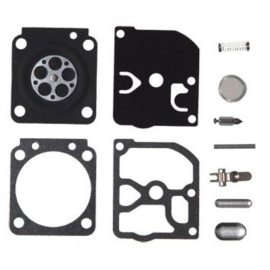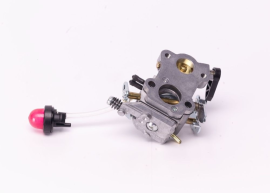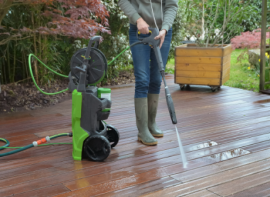What is a curved shaft trimmer?
A curved shaft trimmer has a distinctive bend in the shaft just above the trimmer head. That curve shortens the overall reach slightly and brings the cutting head closer to your feet, giving the tool a more compact, balanced feel.
This design is often found on entry-level or residential-grade trimmers and is a popular choice for smaller yards.
Common features of curved shaft trimmers
Curved shaft models are typically designed with comfort and ease of use in mind. Here are a few of the features that make them appealing for casual yard care:
Shorter shaft with a gentle forward curve
Lighter weight and more balanced for many users
Cutting head sits closer to the user for better visibility
Often uses lower-gauge (thinner) trimmer line
Best for grass and light-duty trimming
Curved shaft trimmers are typically easier to handle, especially if you’re under 6 feet tall or prefer a lighter tool that’s easier to maneuver.
What curved shaft trimmers are best for
These trimmers aren’t made for heavy brush, but they’re excellent for quick jobs in tight spots. They’re best suited for:
Small to medium yards
Light trimming around flower beds, sidewalks, and fences
Homeowners who want a lightweight, easy-to-store trimmer
Occasional use rather than frequent heavy-duty work
Because of their design, curved shaft trimmers generally aren’t ideal for heavy weeds, thick brush, or long sessions—they’re more comfortable for quick jobs in accessible areas.
What is a straight shaft trimmer?
A straight shaft trimmer has—no surprise—a straight, elongated shaft that runs in a direct line from the handle to the cutting head. This design adds reach and durability, and is more commonly found in professional or heavy-duty trimmers.
The straight shaft also houses a longer drive cable or driveshaft, allowing for better torque transfer and compatibility with higher-powered engines.
Common features of straight shaft trimmers
Straight shaft trimmers are built for power, reach, and versatility. They’re typically designed for larger or more demanding jobs and are often preferred by landscapers and experienced DIYers.
Longer, straight shaft provides extended reach
More durable construction with higher torque potential
Compatible with a wider range of accessories and attachments
Often accepts heavier-duty trimmer line
Easier to get under shrubs, decks, and fences
Straight shaft trimmers can feel slightly heavier or more front-weighted, but they offer more power and flexibility in tough conditions.
What straight shaft trimmers are best for
These trimmers are made to handle more than just grass. If you regularly trim large areas or deal with thicker vegetation, a straight shaft trimmer is likely the better fit.
Large properties or frequent trimming
Tough vegetation, tall grass, and heavy weeds
Users who need more reach or better access under obstacles
Landscapers and property owners who want a longer-lasting tool
Some models also support interchangeable attachments—like edgers, brush cutters, and pole saws—making them more versatile for all-around yard maintenance.
What they have in common: Maintenance and repair
Whether you prefer a straight or curved shaft, line trimmers share the same basic maintenance needs. Gas-powered models, in particular, benefit from regular upkeep to extend their life and keep them running reliably. Keeping your trimmer in good shape also reduces strain on the motor and helps it cut more efficiently—no matter which design you’re using.
Routine maintenance tasks
Most maintenance steps are the same regardless of shaft style. Here's what you should check regularly:
Replacing trimmer line
Cleaning the debris shield and trimmer head
Checking and replacing the spark plug
Cleaning or changing the air filter
Inspecting fuel lines and primer bulbs on gas models
If you're not sure where to start, our line trimmer maintenance checklist walks you through what to inspect, clean, and replace.
Common repair needs
Even with regular maintenance, line trimmers occasionally need a fix. Luckily, many of the most common repairs are straightforward and can be done with basic tools at home.
Some issues you might run into include:
Cracked or leaking fuel lines
A clogged or failing carburetor
Hard starting or rough running
Broken pull cords or starter assemblies
If you need to get your trimmer back in working order, our repair guides can help:
Most repairs apply to both shaft types—since the components and replacement process are nearly identical.
Need help tackling another problem? Visit our DIY repair help for gas line trimmers for step-by-step guides, troubleshooting tips, and how-to advice.
You can also shop line trimmer parts and accessories, including air filters, spark plugs, trimmer line, and more—compatible with most straight and curved shaft models.
Which one is right for your yard?
The right trimmer depends on how often you use it, what kind of trimming you do, and what feels comfortable in your hands.
Go with a curved shaft if:
You have a small yard with basic trimming needs
You want something lightweight and easy to store
You prefer a tool with a more compact feel
You’ll mostly be trimming grass around landscaping and walkways
Choose a straight shaft if:
You have a larger yard or frequent trimming jobs
You need to cut through thicker weeds or tough vegetation
You want better reach under trees, decks, or fencing
You’re planning to use attachments or accessories
Once you understand the differences, picking the right trimmer becomes a lot easier. Straight shaft and curved shaft trimmers each have their place in the yard—and knowing how they differ helps you choose the one that fits your property, your trimming needs, and how you like to work.
Whether you're after compact control or extended reach and power, both designs can get the job done with the right maintenance and setup. And when you need new trimmer line, a spool, or replacement parts, we have what you need to keep your trimmer running strong.








